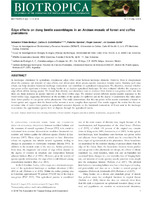Edge effects on dung beetle assemblages in an Andean mosaic of forest and coffee plantations
Date
2016-11-01Author
Villada Bedoya, Sebastián
Cultid Medina, Carlos Andrés
Escobar, Federico
Guevara, Roger
Zurita, Gustavo Andrés
Metadata
Show full item recordAbstract
In landscapes dominated by agriculture, conspicuous edges often occur between landscape elements. However, there is disagreement about the existence and intensity of edge effects, and information about species‐specific responses remains scarce. Studying such edge effects can help elucidate functional landscape connectivity and contribute to agricultural management. We, therefore, assessed whether sun‐grown coffee represents a barrier to dung beetles in an Andean agricultural landscape. We also evaluated whether the response to edge effects differs among species. We found that diversity and abundance tend to decrease from forest to sun‐grown coffee and that there are sharp increases in species turnover at the forest–coffee edge. We detected several different species‐specific responses to the forest–coffee edge, suggesting differences in the mobility of the species (or spillover) and in the degree of penetration that takes place from forest patches to sun‐grown coffee plantations. This study demonstrates that the sun‐grown coffee matrix constitutes a barrier to forest species and suggests that the forest–coffee ecotone is more complex than expected. Our results support the notion that the conservation value of native forest patches in agricultural scenarios depends on the functional connectivity of forest units in the landscape to maximize the opportunities species have to disperse through the agricultural matrix.
Collections
The following license files are associated with this item:




